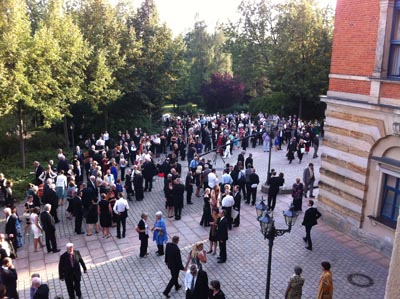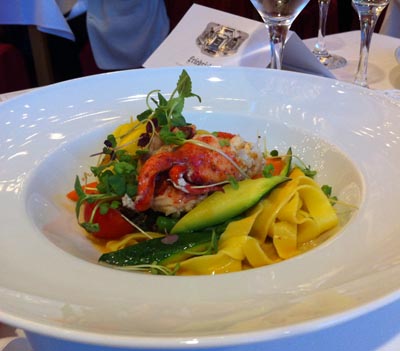 Drenched with sweat, still filled with the rapturous chromaticisms of Tristan und Isolde, I joined two companions for what became a ritual glass of Veuve Clicquot at an outdoor concession in the opera house gardens. Valhalla Bistro. Every tavern, drug store and street is named for a character in Wagner’s oeuvre, or for one of his operas. Two hours later, at the second intermission, we went into the adjoining restaurant—gorgeous with crimson walls and acres of stemware—and had a surprisingly fine dinner. (I say “surprisingly” because this place is, after all, serving sit-down dinners for several hundred people during each intermission—all orders placed in advance and ready the minute you sit down.) I’d saved all year for this trip. And I was ready to enjoy it. Here shown is a Thai-seasoned entree of crab, veggies and pappardalles.
Drenched with sweat, still filled with the rapturous chromaticisms of Tristan und Isolde, I joined two companions for what became a ritual glass of Veuve Clicquot at an outdoor concession in the opera house gardens. Valhalla Bistro. Every tavern, drug store and street is named for a character in Wagner’s oeuvre, or for one of his operas. Two hours later, at the second intermission, we went into the adjoining restaurant—gorgeous with crimson walls and acres of stemware—and had a surprisingly fine dinner. (I say “surprisingly” because this place is, after all, serving sit-down dinners for several hundred people during each intermission—all orders placed in advance and ready the minute you sit down.) I’d saved all year for this trip. And I was ready to enjoy it. Here shown is a Thai-seasoned entree of crab, veggies and pappardalles.
Operas aside, there was much to enjoy in Bayreuth. Well, just enough to fill those first three days before my operas began. Gelato, cold beer, well-made espresso and handsome architecture. I enjoyed one of the ubiquitous free organ concerts that seem to pop up like rave clubs all over Europe. The sounds of Baroque music, played on a Baroque-era organ, in the wedding cake interior of a Baroque church—well, it makes an indelible, and authentic impression. (Later I heard another concert in one of Munich’s many cathedrals, played by a Pauline monk wearing full white robes!)
Adding hype to Wagnerian ambience, one afternoon Thomas Jesatko—Klingsor in this season’s Parsifal— sat outside a centrally-located bookstore and gallantly signed autographs for a pack of female groupies.
I placed flowers on Wagner’s grave. I visited Franz Liszt’s house (right across the street from Wagner’s) and saw every photograph and lithograph of the handsome pianist/composer ever made. For 2 euro it was a harmless, and air-conditioned diversion. At the other end of the cobblestoned pedestrian zone the former town hall had been restored into an attractive art museum, and I was able to consume my fill of etchings by James Ensor, Paul Klee and a surrealist artist I’d never heard of by the name of Casper Walter Rauh. More air-conditioning and outstanding toilets. (Always remember that museums are not only a quick trip to understanding the community—they also provide access to bathrooms and air-conditioning)

